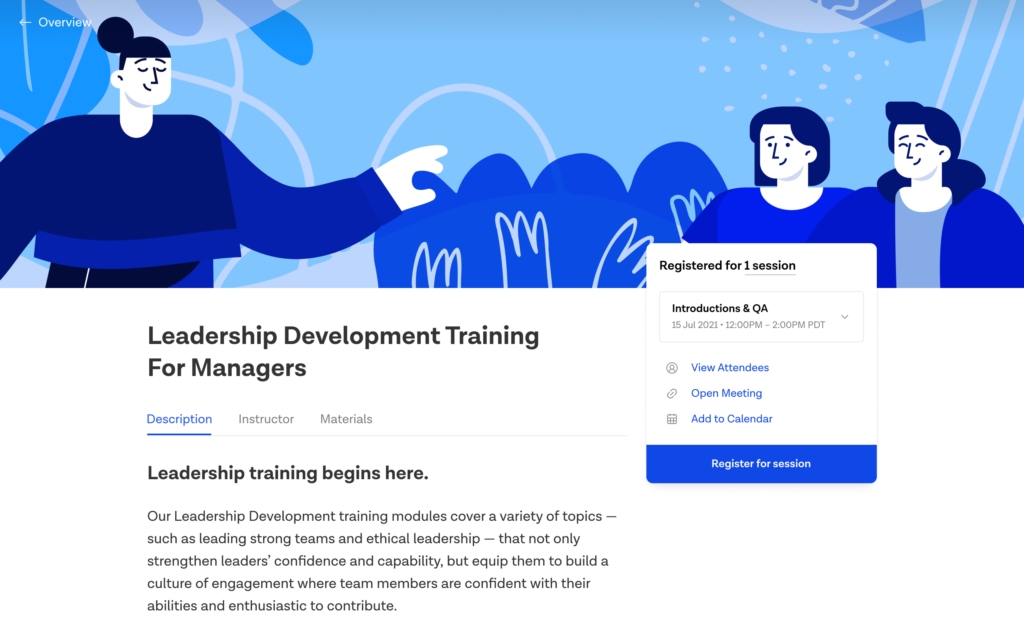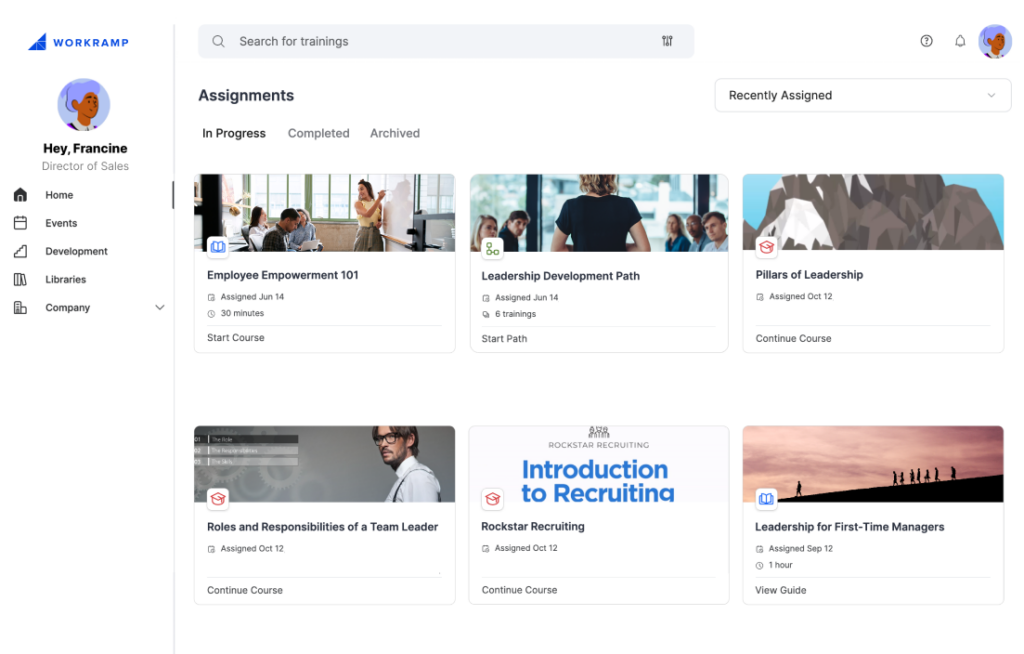LMS Blended Learning: What It Is & How It Works
Anna Spooner | WorkRamp Contributor
View bioLearning Tips Straight to Your Inbox
This isn’t the first or the last time you’ll hear this: learning is not one-size-fits-all.
Based on a 2022 SHRM study, 70 percent of employees preferred online training, 63 percent said they liked in-person training, and 62 percent wanted to participate in hybrid learning.
If you want your L&D programs to engage learners, you must appeal to different learning styles.
LMS blended learning can help employees get the experience they’re looking for while also making it easier to retain new information and engage with colleagues during training.
Knowing how your organization can use a learning management system to create a blended learning environment gives your learners the best elements of both on-demand and in-person training, making training programs more effective and engaging.
In this post:
What is blended learning?
Blended learning includes both self-paced online learning and in-person training, brought together in a cohesive way. Learners cannot skip the on-demand or in-person portions of the program, as both are required to understand the subject fully.
Creating blended learning programs allows learners the flexibility of completing part of the training on their own, as well as giving them the opportunity to engage with colleagues, ask live instructor questions, and get individual help with areas they struggle to understand.
Blended learning example
Suppose you need to improve your sales reps’ ability to handle objections related to a specific competitor that often costs your company business.
To create a program with a blended learning approach, you might decide to develop eLearning courses educating sales reps about your solution’s benefits compared to your competitor’s, offering talking points, and more. Then, there could be in-person practice sessions where reps role-play with each other and/or an instructor, get feedback, and have the opportunity to ask questions and learn from other reps.
Types of blended learning
There are various ways to implement blended learning with an LMS for employee training. Many people immediately assume blended learning has to be 50/50 between eLearning courses and instructor-led training, but there are many other approaches.
Face-to-face blended learning
The face-to-face blended learning model is weighted toward the in-person portion of the program. Instructor-led training classes are either supplemented with eLearning to reinforce concepts, or eLearning is used as homework to be completed before the next in-person class.
This approach can be helpful for learners who are less technologically comfortable or those who benefit from external motivation.
Flipped learning
The flipped learning model is similar to face-to-face except that the eLearning happens first, and the instructor-led sessions reinforce the concepts, allow questions, and allow for practicing the skills with coaching.
When learners do eLearning first, they have more time to come up with questions, which may increase engagement with training.
Rotational learning
In a rotational approach to blended learning, learners are broken into small groups and rotate through stations or learning activities, including live instruction, self-paced assignments, hands-on labs, and eLearning.
Rotational learning gives learners a wide variety of experiences but requires a lot of coordination and organization.
Flexible learning
When a flexible approach is taken, the learner controls their learning path in the LMS and chooses how to focus their training. The in-person component provides a mentor or coach to help them practice new skills.
This allows learners access to expertise when they need it, and you can make it easier on mentors/coaches by having them offer specific “office hours” rather than being on-call for learners at all times.
Online-driven learning
Finally, online-driven blended learning is weighted toward the eLearning portion of the program. In these programs, learners go through self-directed courses and can ask instructors questions through a message board or chat system.
This maximizes autonomy, but less confident learners may be hesitant to ask questions and instead will struggle to learn the material on their own.
What is a blended learning LMS?
A blended learning LMS is a learning management system with the features your organization needs to offer blended learning for your team.

The Learning Cloud from WorkRamp is a great example of a blended learning LMS. The platform simplifies instructor-led training with easy-to-use virtual event features, attendance tracking, conferencing, and event recordings.
At the same time, creating online learning courses is intuitive, and learners find it easy to access and complete training at the time that works best for them. Your team can use prebuilt content and multiple media types while organizing content in the LMS for easy access.
Read more: 16 Must-Have LMS Features: The Key Elements for Effective eLearning
Benefits of blended learning in your LMS
There are a variety of benefits to using your LMS for blended learning. You can use the same foundation for all your learning programs, including sales enablement, customer training, and partner education, and you also gain the following benefits.
A variety of learning mediums
Learner engagement and information retention go up when you have a variety of media in the learning process, such as articles, videos, games, quizzes, and other interactive elements.
The right learning platform makes this easy by supporting various file types in eLearning and instructor-led training.
Read more: What is Multimodal Learning? Examples, Strategies, & Benefits
Personalized learning paths
Using your LMS for blended learning allows learners to choose training courses based on their interests, skill needs, and career aspirations. Perhaps team members choose specific blended learning programs based on their needs, or each includes different eLearning options that give learners a slightly different focus.
Either way, learners can control the direction of their growth.
Read more: The Indispensable Power of Personalized L&D
Seamless course management
When you manage blended learning within your LMS, you don’t have to worry about instructor-led training being siloed from eLearning.
Instead, everything is integrated, with course evaluations, training analytics, and post-training results tracking all occurring on the same platform.
Higher engagement
Because blended learning gives learners the best of both worlds—on-demand learning and the opportunity to engage, ask questions, and get feedback—engagement is much higher. That means you’ll get better results, better post-training reviews, and overall have a bigger impact on company results.
Greater flexibility and customization
Because blended learning includes in-person and online components, there’s more flexibility when it comes to balancing training with work. That makes it easier for employees to take part in training programs and benefit from skill development and career advancement.
Plus, learners can participate in training courses when they’re most motivated to grow and learn.
How to create a blended learning program with your LMS
How can you capture the many benefits of blended learning in your organization? The following steps will help you create a successful program using your LMS as the foundation.
Define learning objectives
As with any training program, knowing what you want to achieve is important. The L&D team may set separate learning objectives for each blended learning program since each one will have its own focus, skill work, and balance between eLearning and instructor-led training.
Read more: Align L&D with Business Strategy: Maximize Organizational Performance
Prioritize engagement
Blended learning aims to maximize learner engagement, so ensure your L&D team designs courses with that in mind. Multiple media types, gamification, and other interactive elements will keep learners focused and engaged.
Customize learning paths
Every employee in your organization has their own training needs, whether it’s specific skills that need improvement, interests they want to pursue, or career goals they’d like to achieve.
By customizing learning paths within blended learning programs, your L&D team can support everyone’s goals, making training meaningful for every team member.
Include learning assessments
How well are the training programs doing to improve employee performance, move careers forward, and fill skill gaps in the organization? You’ll never know if you don’t measure results. Assessments let you know how well a learner retained the information, and you can then track their performance metrics over time to see how they improve.
Add social learning opportunities
Social learning makes training more fun and effective. Learners can share their takeaways and how they’re applying the new information with colleagues and get the trainer’s feedback.
Employees benefit from seeing how others use information and can imitate them to improve their performance. Being able to talk about what each person is gaining from the course helps create a learning culture that fosters growth and continuous improvement.
Use the best LMS for blended learning

For blended learning to be effective, you can’t silo in-person training from eLearning on different platforms. Instead, you need an LMS with both, plus measurement tools, social learning features, assessments, and support for various file types.
The Learning Cloud has everything you need in one place, making it easy to seamlessly integrate both parts of blended learning.
If you’re ready to see the benefits of combining in-person and online learning in your organization, we’re here to help. Contact us for a free, personalized demo.
Complete the form for a custom demo.
Recent Posts
- Top LMS Integrations That Power Smarter, Faster Learning July 2, 2025
- Introducing WorkRamp Analytics Studio: Unlocking Your Data Insights with AI June 30, 2025
- 11 AI LMS for AI-Powered Learning June 27, 2025
- The Best LMS Platforms for Customer Retention (2025 Guide) June 27, 2025
- 11 Best AI Learning Platforms June 16, 2025
Anna Spooner
WorkRamp ContributorAnna Spooner is a digital strategist and marketer with over 11 years of experience. She writes content for various industries, including SaaS, medical and personal insurance, healthcare, education, marketing, and business. She enjoys the process of putting words around a company’s vision and is an expert at making complex ideas approachable and encouraging an audience to take action.
You might also like
Create engaging eLearning content for your teams
eLearning gives organizations the flexibility that other online courses can offer, but creating courses that are engaging and impactful can be harder than you think.
Read More
Find the best LMS to empower employees, customers, and partners
Learning management systems, or LMSs, are an indispensable tool for increasing team productivity and effectiveness. But with multiple platforms, the key lies in choosing the right one, as not all LMS are created equal.
Read More
Leveraging L&D to set your team up for success
Use these L&D strategies to future-proof your organization and retain skilled team members.
Read More
Ready to Explore Online Learning Platforms?
Get in touch to learn how WorkRamp can help you achieve your training goals.
Request a Demo




